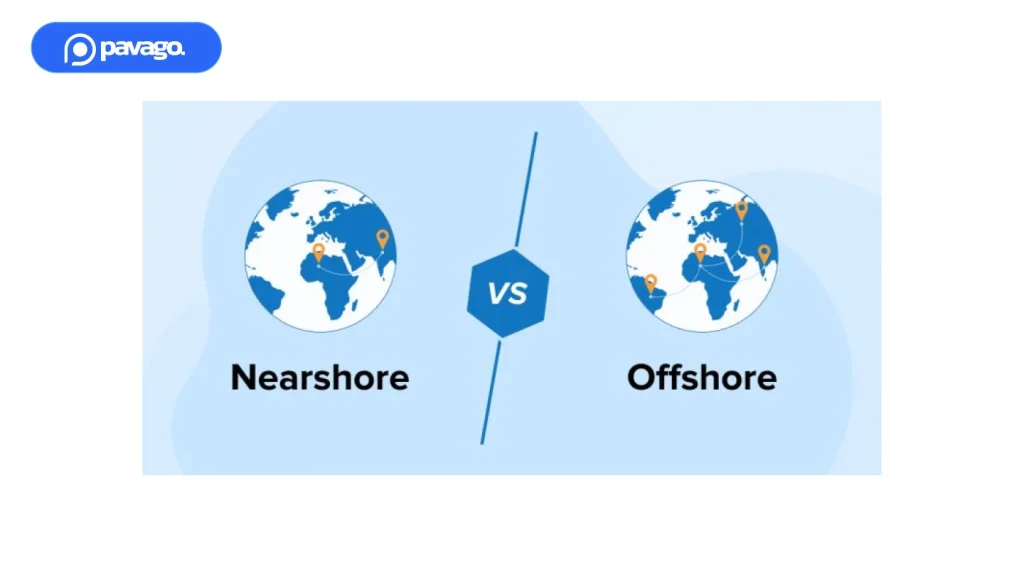In today’s challenging economic climate, where rising inflation and dwindling profits put pressure on businesses to tighten their belts. One effective strategy to stay competitive is outsourcing.
According to outsourcing statistics, 83% of SMBs managed to reduce costs using outsourcing. Although outsourcing has been around for years, recent statistics indicate that outsourcing is a strategic decision by SMBs to enhance business operations while managing overhead costs.
When it comes to outsourcing, there are two main categories: nearshore and offshore. In this blog, we will discuss the difference between these two categories, the benefits of both, and help you decide which one is best for your business.
Nearshore vs Offshore: What is the Difference?
Nearshore and offshore are two different approaches to outsourcing foreign employees. Each approach involves partnering with a third party to handle specific responsibilities within your company, but they differ significantly in where this talent is located. This geographical distinction can profoundly impact your working relationships, communication flow, and overall business growth.
Nearshore Outsourcing
Nearshore outsourcing involves hiring remote employees from geographically close countries, often within the same or similar time zones.
For example, a US-based company might outsource remote talent from Latin America such as Mexico, Argentina, or Costa Rica. This proximity facilitates smoother communication and collaboration due to overlapping time zones and similar Latin Cultures.
Offshore Outsourcing
Offshore outsourcing means hiring offshore employees from a distant country, often on different continents. For example, a US-based company might hire a full-time sales development representative from Pakistan, India, or the Philippines.
Most SMBs opt for this option because offshore countries have relatively lower monthly wages than the US or Latin America.
💡 DID YOU KNOW? Offshore in-house teams are not contracted for a specific project or function but are full-time employees of your organization.
Key Differences

Geographical Proximity: Nearshore outsourcing benefits from minimal time zone differences, making real-time collaboration easier. Offshore outsourcing may face challenges with asynchronous communication due to significant time zone gaps.
Cultural Alignment: Nearshore locations often share cultural similarities with the client company, reducing potential misunderstandings. Offshore locations may have greater cultural differences, which can impact communication and project management.
Cost Comparison: Nearshore vs Offshore
Besides being efficient and productive, small businesses also have to consider costs. A Deloitte survey found that 59% of organizations selected outsourcing as a method to reduce costs. In the IT industry, the number of businesses jumped to 87%.
Offshore outsourcing generally offers lower labor costs.
💡 For instance, in 2025, the average salary for a mid-level marketer in Pakistan is around $800-$1000, while in Latin America, nearshore rates are slightly higher, averaging $1000-$1500 per month.
Communication and Collaboration
Time Zone Alignment
Nearshore outsourcing allows for significant overlap in working hours, facilitating real-time communication and faster decision-making. For example, a US company working with a nearshore team in Costa Rica can easily conduct daily stand-up meetings and collaborative sessions.
In many offshore companies, team members work shift schedules to overlap with their counterparts. For example, all Pavago employees work from 9 a.m. to 6 p.m. EST, providing a full 12 hours of overlap with US-based companies. This means their working hours are completely aligned with the US time zone.
This work setup creates plenty of time for daily meetings and collaboration for in-house teams.
Cultural Alignment
Cultural similarities in nearshore outsourcing reduce the risk of miscommunication. Shared business practices and work ethics streamline project management and foster better team integration. In contrast, offshore teams might require more effort and training in aligning cultural differences.
Language Proficiency
If you outsource in Latin America, their English language proficiency is higher compared to offshore employees. That is why it becomes crucial to vet candidates based on their English proficiency along with technical skills while hiring from distant countries.
💡 For example, Pavago finds top-tier offshore talent from Pakistan because many professionals in Pakistan are trained to communicate effectively in English, particularly those working in IT, customer service, and other outsourcing industries.
Tools and Strategies
To bridge communication gaps, businesses often use project management tools like Asana, and Trello, and communication platforms like Slack and Zoom. At Pavago, we do daily stand-up on Zoom to make sure that everyone is on track and working to achieve a common goal.
In 2025, leveraging AI-driven collaboration tools can further enhance productivity by automating routine tasks and providing real-time transcriptions. For example, Sembly for meeting minutes and transcription.
Access to Global Talent

Quality and Availability of Talent
Offshore locations like Pakistan, India, and the Philippines offer a vast pool of skilled professionals, often with specialized expertise. However, nearshore regions, particularly in Latin America, are rapidly catching up with significant investments in tech education and training.
Specialization
While offshore teams may have broader access to specialized skills, nearshore teams are increasingly known for their proficiency in technologies relevant to the US market. Countries like Colombia and Argentina have become hotspots for IT talent with strong English proficiency and cultural affinity
Challenges and Mitigation Strategies
Common Challenges
Nearshore: Higher costs compared to offshore options, limited talent pool for specialized skills.
Offshore: Communication barriers, time zone differences, cultural misalignments.
Mitigation Strategies
For Nearshore: Broaden the search to multiple nearshore markets to find the best talent. Use collaborative tools to enhance communication and project management.
For Offshore: Invest in cultural training for both teams, establish clear communication protocols, and use advanced project management tools to coordinate work across time zones.
Nearshore vs Offshore: Which One is Best for SMBs?
When choosing between offshore vs. nearshore, offshoring often stands out as the best choice for your business, particularly if you’re looking to cut costs on recruitment and payrolls.
Offshoring isn’t just about saving money; it also opens the door to a diverse global talent pool, allowing you to find top-notch expertise from around the world. Plus, you can maintain full managerial control over your projects, ensuring quality and consistency.
While some offshoring locations might not be as convenient as nearshoring ones, the cost benefits can outweigh these minor drawbacks. Ultimately, offshoring offers a powerful opportunity for business growth by tapping into lower costs and a broad range of skills—just make sure to partner with a reliable provider you can count on.
Choose the Right Offshoring Partner
Businesses need to invest in proper training and support for their offshore in-house teams to ensure they have the same resources as the local in-house teams. And that’s where an on-the-ground offshoring partner comes into play.
You must be wondering, where can I find a reliable offshoring partner? Well, Pavago, not only finds the best hire for you but also provides comprehensive support services such as payroll management, seamless onboarding, compliance assurance, and ongoing training.
How do we do it?
We make it happen by ensuring seamless communication between candidates and clients. We also offer initial training by leveraging the right tools and technologies to stay connected. For example video conferencing on Zoom, chat applications like Slack, and project management software such as Trello and Asana—enable real-time collaboration and communication.
✌️ Want to know more about what Pavago can offer? Talk to us, and let’s discuss how we can help you achieve the right results for your business.











![Best BPO Companies in USA [2025]](https://blog.pavago.co/wp-content/uploads/2025/06/BPO-Companies-in-the-US-1024x576.webp)




